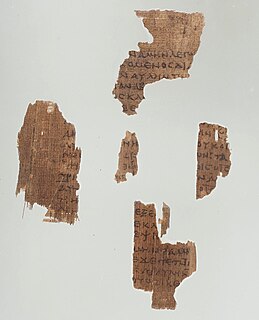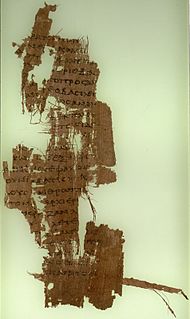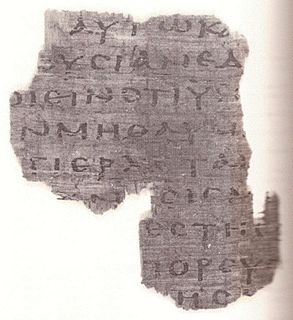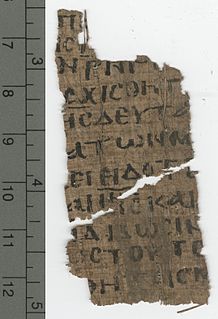 W
WPapyrus 2 is an early copy of the New Testament in Greek and Coptic. It is a papyrus fragment of a copy of the Gospel of John dating to the sixth century. It is currently housed at the Egyptian Museum, Florence. There is a portion of Luke 7:22-26.50 in Coptic on the reverse of the fragment.
 W
WPapyrus 5, designated by siglum 𝔓5, is an early copy of the New Testament in Greek. It is a papyrus manuscript of the Gospel of John dating palaeographically to the early 3rd century. The papyrus is housed in the British Library. It has survived in a very fragmentary condition.
 W
WPapyrus 5, designated by siglum 𝔓5, is an early copy of the New Testament in Greek. It is a papyrus manuscript of the Gospel of John dating palaeographically to the early 3rd century. The papyrus is housed in the British Library. It has survived in a very fragmentary condition.
 W
WPapyrus 6, designated by 𝔓6 or by ε 021, is a fragmentary early copy of the New Testament in Greek and Coptic (Akhmimic). It is a papyrus manuscript of the Gospel of John that has been dated paleographically to the 4th century. The manuscript also contains text of the First Epistle of Clement, which is treated as a canonical book of the New Testament by the Coptic Church. The major part of the codex is lost.
 W
WPapyrus 22, designated by 22, is an early copy of the New Testament in Greek. It is a papyrus manuscript of the Gospel of John, only containing extant John 15:25-16:2, 21-32. The manuscript has been paleographically assigned to the early 3rd century. It is the only identified New Testament papyrus to have been written originally as a roll; not a codex or re-using the back of a scroll.
 W
WPapyrus 28, designated by 𝔓28, is an early copy of the New Testament in Greek. It is a papyrus manuscript of the Gospel of John, it contains only one leaf with the text of the Gospel of John 6:8-12.17-22. The manuscript paleographically has been assigned to the late 3rd century.
 W
WPapyrus 36, designated by siglum 36, is a copy of the New Testament in Greek. It is a papyrus manuscript of the Gospel of John, it contains only John 3:14-18.31-32.34-35. The manuscript palaeographically has been assigned to the 6th century.
 W
WPapyrus 39, signed by 39, is an early copy of the New Testament in Greek. It is a papyrus manuscript of the Gospel of John, it contains only John 8:14-22. The manuscript paleographically had been assigned to the 3rd century. Written by professional scribe, in 25 lines per page, in large, beautiful letters. It has numbered pages.
 W
WPapyrus 45 is an early New Testament manuscript which is a part of the Chester Beatty Papyri. It has been paleographically dated to the early 3rd century CE. It contains the texts of Matthew 20-21 and 25-26; Mark 4-9 and 11-12; Luke 6-7 and 9-14; John 4-5 and 10-11; and Acts 4-17. The manuscript is currently housed at the Chester Beatty Library, Dublin, Ireland, except for one leaf containing Matt. 25:41-26:39 which is at the Österreichische Nationalbibliothek, Vienna.
 W
WThe Rylands Library Papyrus P52, also known as the St John's fragment and with an accession reference of Papyrus Rylands Greek 457, is a fragment from a papyrus codex, measuring only 3.5 by 2.5 inches at its widest ; and conserved with the Rylands Papyri at the John Rylands University Library Manchester, UK. The front (recto) contains parts of seven lines from the Gospel of John 18:31–33, in Greek, and the back (verso) contains parts of seven lines from verses 37–38. Since 2007, the papyrus has been on permanent display in the library's Deansgate building.
 W
WThe Rylands Library Papyrus P52, also known as the St John's fragment and with an accession reference of Papyrus Rylands Greek 457, is a fragment from a papyrus codex, measuring only 3.5 by 2.5 inches at its widest ; and conserved with the Rylands Papyri at the John Rylands University Library Manchester, UK. The front (recto) contains parts of seven lines from the Gospel of John 18:31–33, in Greek, and the back (verso) contains parts of seven lines from verses 37–38. Since 2007, the papyrus has been on permanent display in the library's Deansgate building.
 W
WPapyrus 63, designated by 63, is a copy of the New Testament in Greek. It is a papyrus manuscript of the Gospel of John. The surviving text of John are verses 3:14-18; 4:9-10. The manuscript paleographically had been assigned to the 4th century.
 W
WPapyrus 66 is a near complete codex of the Gospel of John, and part of the collection known as the Bodmer Papyri.
 W
WPapyrus 75 is an early Greek New Testament papyrus. It is generally described as "the most significant" papyrus of the New Testament to be discovered so far. This evaluation of the manuscript is a result of the early date that has usually been assigned to it and the fact that its text so closely resembles that of the fourth-century Codex Vaticanus. However, the early date of 75, and therefore its importance for the textual criticism of the New Testament, was called into question in 2016.
 W
WPapyrus 90, designated by 90, is a small fragment from the Gospel of John 18:36-19:7 dating palaeographically to the late 2nd century.
 W
WPapyrus 95, designated by siglum 95, is an early copy of the New Testament in Greek. It is a papyrus manuscript of the Gospel of John. The surviving texts of John are verses 5:26-29,36-38. The manuscript palaeographically has been assigned to the early 3rd century.
 W
WPapyrus 106, designated by 106, is a copy of the New Testament in Greek. It is a papyrus manuscript of the Gospel of John, containing verses 1:29-35 & 1:40-46 in a fragmentary condition. The manuscript has been paleographically assigned to the early 3rd century. The manuscript is currently housed at the Sackler Library at Oxford.
 W
WPapyrus 107, designated by 107, is a copy of the New Testament in Greek. It is a papyrus manuscript of the Gospel of John, containing verses 17:1-2 & 17:11 in a fragmentary condition. The manuscript has been paleographically assigned to the early 3rd Century CE. The manuscript currently is housed at the Sackler Library at Oxford.
 W
WPapyrus 108, designated by 108, is a copy of the New Testament in Greek. It is a papyrus manuscript of the Gospel of John, containing verses 17:23-24 & 18:1-5 in a fragmentary condition. The manuscript has been paleographically assigned to the late 2nd or early 3rd Century CE. The manuscript is currently housed at the Papyrology Rooms of the Sackler Library at Oxford University.
 W
WPapyrus 109, designated by siglum 109, is a copy of the New Testament in Greek. It is a papyrus manuscript of the Gospel of John, containing verses 21:18-20 & 21:23-25 in a fragmentary condition. The manuscript has been palaeographically assigned by the INTF to the early 3rd century CE. Papyrologist Philip Comfort dates the manuscript to the middle-late 2nd century CE. The manuscript is currently housed at the Papyrology Rooms of the Sackler Library at Oxford.
 W
WPapyrus 119, designated by 119, is an early copy of a small part of the New Testament in Greek found among the Oxyrhynchus Papyri. It is a manuscript of the Gospel of John.
 W
WPapyrus 120, designated by 120, is an early copy of a small part of the New Testament in Greek. It is a papyrus manuscript of the Gospel of John. The surviving texts of John are verses 1:25-28,38-44, they are in a fragmentary condition. The manuscript palaeographically has been assigned to the 4th century (INTF).
 W
WPapyrus 121, designated by 121, is an early copy of the New Testament in Greek. It is a papyrus manuscript of the Gospel of John. The surviving texts of John are only fragments of verses 19:17-18,25-26. They are in very fragmentary condition. The manuscript paleographically has been assigned to the 3rd century by the INTF.
 W
WPapyrus 122, designated by 122, is an early copy of the New Testament in Greek. It is a papyrus manuscript of the Gospel of John.
 W
WPapyrus 128, designated by 𝔓128, is a copy of a small part of the New Testament in Greek. It is a papyrus manuscript of the Gospel of John, containing verses 9:3-4; 12:16-18. The manuscript paleographically has been assigned to the 6th or 7th century.